| ________________
CM . . .
. Volume XVIII Number 29. . . .March 30, 2012 
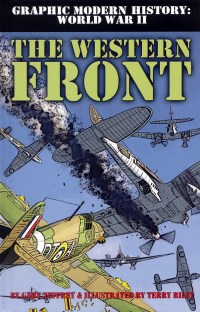 |
The Western Front. (Graphic Modern History: World War II).
Gary Jeffrey. Illustrated by Terry Riley.
St. Catharines, ON: Crabtree, 2012.
48 pp., pbk. & hc., $11.95 (pbk.), $21.56 (RLB.).
ISBN 978-0-7787-4203-6 (pbk.), ISBN 978-0-7787-4196-1 (RLB).
Subject Headings:
World War, 1939-1945-Europe-Comic books, strips, etc.
World War, 1939-1945-Europe-Juvenile literature.
Graphic novels.
Grades 5-8 / Ages 10-13.
Review by Dave Jenkinson.
*** /4
|
| |
|
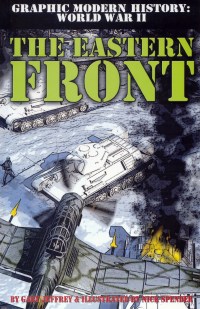 |
The Eastern Front. (Graphic Modern History: World War II).
Gary Jeffrey. Illustrated by Nick Spender.
St. Catharines, ON: Crabtree, 2012.
48 pp., pbk. & hc., $11.95 (pbk.), $21.56 (RLB.).
ISBN 978-0-7787-4201-2 (pbk.), ISBN 978-0-7787-4194-7 (RLB).
Subject Headings:
World War, 1939-1945-Europe-Comic books, strips, etc.
World War, 1939-1945-Europe-Juvenile literature.
Graphic novels.
Grades 5-8 / Ages 10-13.
Review by Dave Jenkinson.
*** /4
|
| |
|
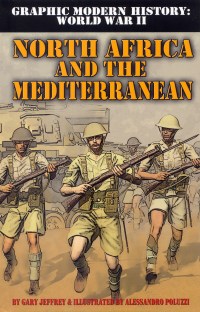 |
North Africa and the Mediterranean (Graphic Modern History: World War II).
Gary Jeffrey. Illustrated by Alessandro Poluzzi.
St. Catharines, ON: Crabtree, 2012.
48 pp., pbk. & hc., $11.95 (pbk.), $21.56 (RLB.).
ISBN 978-0-7787-4200-5 (pbk.), ISBN 978-0-7787-4193-0 (RLB).
Subject Headings:
World War, 1939-1945-Campaigns-Africa, North-Comic books, strips, etc.
World War, 1939-1945-Campaigns-Africa, North-Juvenile literature.
World War, 1939-1945-Campaigns-Mediterranean Region-Comic books, strips, etc.
World War, 1939-1945-Campaigns-Mediterranean Region-Juvenile literature.
Graphic novels.
Grades 5-8 / Ages 10-13.
Review by Dave Jenkinson.
*** /4
|
| |
|
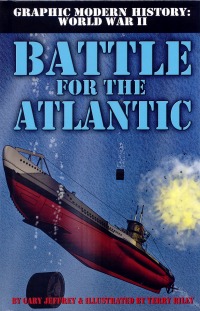 |
Battle for the Atlantic. (Graphic Modern History: World War II).
Gary Jeffrey. Illustrated by Terry Riley.
St. Catharines, ON: Crabtree, 2012.
48 pp., pbk. & hc., $11.95 (pbk.), $21.56 (RLB.).
ISBN 978-0-7787-4199-2 (pbk.), ISBN 978-0-7787-4192-3 (RLB).
Subject Headings:
World War, 1939-1945-Campaigns-Atlantic Ocean-Comic books, strips, etc.
World War, 1939-1945-Campaigns-Atlantic Ocean-Juvenile literature.
Graphic novels.
Grades 5-8 / Ages 10-13.
Review by Dave Jenkinson.
*** /4
|
| |
|
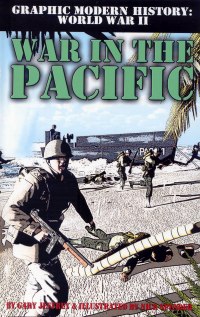 |
War in the Pacific. (Graphic Modern History: World War II).
Gary Jeffrey. Illustrated by Nick Spender.
St. Catharines, ON: Crabtree, 2012.
48 pp., pbk. & hc., $11.95 (pbk.), $21.56 (RLB.).
ISBN 978-0-7787-4204-3 (pbk.), ISBN 978-0-7787-4197-8 (RLB).
Subject Headings:
World War, 1939-1945-Campaigns-Pacific area-Comic books, strips, etc.
World War, 1939-1945-Campaigns-Pacific area-Juvenile literature.
Graphic novels.
Grades 5-8 / Ages 10-13.
Review by Dave Jenkinson.
*** /4
|
| |
|
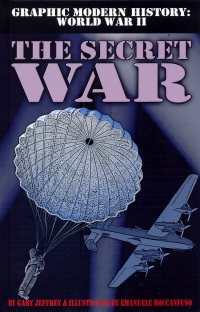 |
The Secret War. (Graphic Modern History: World War II).
Gary Jeffrey. Illustrated by Emanuele Boccanfuso.
St. Catharines, ON: Crabtree, 2012.
48 pp., pbk. & hc., $11.95 (pbk.), $21.56 (RLB.).
ISBN 978-0-7787-4202-9 (pbk.), ISBN 978-0-7787-4195-4 (RLB).
Subject Headings:
World War, 1939-1945-Secret service-Comic books, strips, etc.
World War, 1939-1945-Secret service-Juvenile literature.
Graphic novels.
Grades 5-8 / Ages 10-13.
Review by Dave Jenkinson.
*** /4
|
| |
|

excerpt:
The Battle of Britain
In the summer of 1940, Hitler felt he had won the war. He couldn't understand why the British government was "...set on fighting to the finish." To invade England was risky. Germany had only river barges with which to launch an amphibious assault ,and, before that, the British air force had to be neutralized.
Between July and October, waves of German bombers pounded Britain's air bases before turning their attention to its cities. Opposing the Luftwaffe were the brave pilots of the RAF in their Hurricanes and Spitfires. The Luftwaffe had lots of pilots but not enough planes, while Britain had the planes but lacked pilots. In the end, the invention of radar, a secret weapon, defeated the Luftwaffe and the invasion of Britain was postponed.
Think of each of each of the six volumes in Crabtree's "Graphic Modern History: World War II" series as being a history sandwich. The top slice of bread consists of the table of contents plus four pages of prose, illustrated with numerous coloured photos, that provide a brief, factual context for that particular military "campaign." The bottom bread slice has two text pages, also illustrated, that succinctly explain how this portion of the war concluded. This slice also contains a two-page "Glossary" and a one-page "Index." The "meat" of the sandwich consists of three "pieces" of true, personal stories that are related in the style of a comic book. Given that most of the book is devoted to what could be characterized as recreational reading, the index is really superfluous.
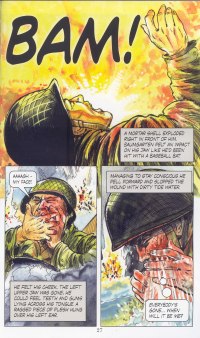 In the The Western Front, readers meet Pilot Officer John Bentley-Beard, an RAF Hurricane pilot, who, on September 27, 1940, was part of the Battle of Britain. Ironically, after shooting down a number of German bombers and fighter planes, Bentley-Beard was, himself, shot down by "friendly" antiaircraft fire. Harold Baumgarten was a soldier with the US 116th Infantry Regiment who landed on Omaha Beach on D-Day, June 6, 1944, and was seriously wounded. On March 7, 1945, Sergeant Alexander A. Drabik was part of the US First Army who were successful in securing the Ludendorff Bridge at Remagen which then allowed allied troops to cross the Rhine River into Germany. Drabik's particular claim to fame was that he "was the first man across - the first invader to reach the east bank of the Rhine River since the time of Napoleon."
In the The Western Front, readers meet Pilot Officer John Bentley-Beard, an RAF Hurricane pilot, who, on September 27, 1940, was part of the Battle of Britain. Ironically, after shooting down a number of German bombers and fighter planes, Bentley-Beard was, himself, shot down by "friendly" antiaircraft fire. Harold Baumgarten was a soldier with the US 116th Infantry Regiment who landed on Omaha Beach on D-Day, June 6, 1944, and was seriously wounded. On March 7, 1945, Sergeant Alexander A. Drabik was part of the US First Army who were successful in securing the Ludendorff Bridge at Remagen which then allowed allied troops to cross the Rhine River into Germany. Drabik's particular claim to fame was that he "was the first man across - the first invader to reach the east bank of the Rhine River since the time of Napoleon."
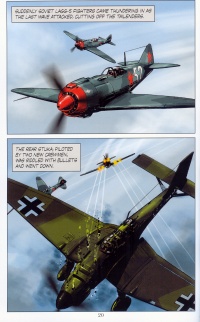 The Eastern Front focuses on Germany's war with Russia, and two of the three stories actually feature the "bad" guys, the Germans. On November 22, 1942, Günter K. Koschorrek, a private in the 21st Panzer Grenadier Regiment which had escaped the Russian encirclement of Stalingrad, is confronted by a Russian tank supported by infantry. On March 24, 1944, Group Commander Hans Rudel leads a squadron of Stuka aircraft in attempting to bomb the Yampol bridge on the Dniester River in Ukraine in order to slow the Russian advance. When one of his pilots crash lands on the Russian side of the river, Rudel sets his own plane down to rescue the two person crew. When Rudel's plane's wheels get stuck in the mud, he, along with the other three airmen, attempts to reach the German lines on foot. One man drowns, and the other three are captured; however, Rudel manages to escape, and, although wounded, he makes his way to safety and is back in the air flying combat missions three days later. On July 14, 1944, Platoon Commander Evgeni Bessonov had just dismounted from riding on a T34 tank when it was hit by a high explosive shell and exploded near the border of Ukraine and Romania. Ordered to capture a heavily defended village, Lieutenant Bessonov led his men into withering enemy fire and, amazingly, survived.
The Eastern Front focuses on Germany's war with Russia, and two of the three stories actually feature the "bad" guys, the Germans. On November 22, 1942, Günter K. Koschorrek, a private in the 21st Panzer Grenadier Regiment which had escaped the Russian encirclement of Stalingrad, is confronted by a Russian tank supported by infantry. On March 24, 1944, Group Commander Hans Rudel leads a squadron of Stuka aircraft in attempting to bomb the Yampol bridge on the Dniester River in Ukraine in order to slow the Russian advance. When one of his pilots crash lands on the Russian side of the river, Rudel sets his own plane down to rescue the two person crew. When Rudel's plane's wheels get stuck in the mud, he, along with the other three airmen, attempts to reach the German lines on foot. One man drowns, and the other three are captured; however, Rudel manages to escape, and, although wounded, he makes his way to safety and is back in the air flying combat missions three days later. On July 14, 1944, Platoon Commander Evgeni Bessonov had just dismounted from riding on a T34 tank when it was hit by a high explosive shell and exploded near the border of Ukraine and Romania. Ordered to capture a heavily defended village, Lieutenant Bessonov led his men into withering enemy fire and, amazingly, survived.
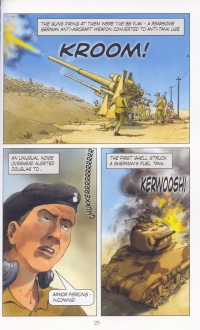 In North Africa and the Mediterranean, when the Mediterranean island of Crete is attacked by German glider-borne troops and paratroopers on May 20, 1941, Second Lieutenant Peter Wildey is one of the soldiers responsible for defending the island's airport. Keith Douglas is one of the British tank commanders during the second battle of El Alamein in Egypt, North Africa, on October 30, 1942. Canadian Sydney Thompson, a Lieutenant Colonel with the Seaforth Highlanders, was one of thousands of soldiers in the Allied Eighth Army who were attempting to capture the German-defended city of Ortona, Italy, on December 22, 1943.
In North Africa and the Mediterranean, when the Mediterranean island of Crete is attacked by German glider-borne troops and paratroopers on May 20, 1941, Second Lieutenant Peter Wildey is one of the soldiers responsible for defending the island's airport. Keith Douglas is one of the British tank commanders during the second battle of El Alamein in Egypt, North Africa, on October 30, 1942. Canadian Sydney Thompson, a Lieutenant Colonel with the Seaforth Highlanders, was one of thousands of soldiers in the Allied Eighth Army who were attempting to capture the German-defended city of Ortona, Italy, on December 22, 1943.
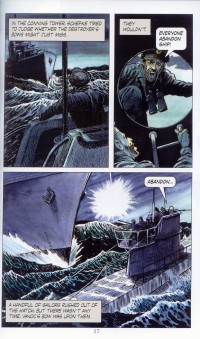 Convoys of supplies from North America were essential for Britain's survival during World War II, but the ships of the Allies were threatened by German U-boats and surface ships. In Battle for the Atlantic, readers see two U-boats, the U-100 and U-99, captained respectively by Kapitanleutnant Joachim Schepke and Korvettenkapitan Otto Kretschmer, both being sunk on the evening of March 16, 1941, while attacking the same convoy in the North Atlantic. Just 10 days later, the German navy suffered an even more significant loss when Sub-Lieutenant John Moffat, a Swordfish pilot aboard the aircraft carrier HMS Ark Royal, was able to launch a torpedo which damaged the steering of the Bismark, "the heaviest, most powerfully armed battleship in the world." Moffat's damaging the Bismark allowed other British surface vessels and aircraft to overtake and sink the pride of the German navy.
Convoys of supplies from North America were essential for Britain's survival during World War II, but the ships of the Allies were threatened by German U-boats and surface ships. In Battle for the Atlantic, readers see two U-boats, the U-100 and U-99, captained respectively by Kapitanleutnant Joachim Schepke and Korvettenkapitan Otto Kretschmer, both being sunk on the evening of March 16, 1941, while attacking the same convoy in the North Atlantic. Just 10 days later, the German navy suffered an even more significant loss when Sub-Lieutenant John Moffat, a Swordfish pilot aboard the aircraft carrier HMS Ark Royal, was able to launch a torpedo which damaged the steering of the Bismark, "the heaviest, most powerfully armed battleship in the world." Moffat's damaging the Bismark allowed other British surface vessels and aircraft to overtake and sink the pride of the German navy.
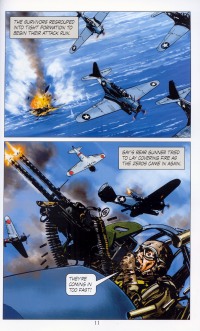 War in the Pacific deals with both the land and sea battles that were fought in this theatre of war. Ensign George H. Gay, Jr. piloted a Douglas Devastator torpedo bomber during the Battle of Midway on June 4, 1942, in which aircraft from the carrier USS Hornet found the attacking Japanese fleet and were able to sink four carriers. First Class Seaman James Fahey was a loader on the starboard gun mount of the light cruiser USS Montpelier at Leyte Gulf on November 27, 1944, when waves of Japanese kamikaze pilots attacked his task force. One of the most famous photos of World War II is the raising of the US flag over Mount Suribachi on February 19, 1945, during the Battle of Iwo Jima. One of the marines who made it to the top of that mountain on that historic day was 19-year-old Corporal Frank Walker.
War in the Pacific deals with both the land and sea battles that were fought in this theatre of war. Ensign George H. Gay, Jr. piloted a Douglas Devastator torpedo bomber during the Battle of Midway on June 4, 1942, in which aircraft from the carrier USS Hornet found the attacking Japanese fleet and were able to sink four carriers. First Class Seaman James Fahey was a loader on the starboard gun mount of the light cruiser USS Montpelier at Leyte Gulf on November 27, 1944, when waves of Japanese kamikaze pilots attacked his task force. One of the most famous photos of World War II is the raising of the US flag over Mount Suribachi on February 19, 1945, during the Battle of Iwo Jima. One of the marines who made it to the top of that mountain on that historic day was 19-year-old Corporal Frank Walker.
Spies and sabotage are the stuff of The Secret War. Jan Kubis and Josef Gabcik attempted to assassinate SS Reinhard Heydrich, aka "Hitler's Hangman," on May 27, 1942 in Prague, Czechoslovakia. Benjamin Cowburn led a group of saboteurs into a railway roundhouse in Troyes, France, in April 1943, where they planted timed plastic explosives under 13 locomotives. 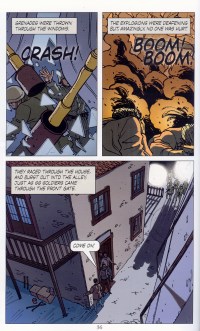 On August 10, 1944, René Joyeuse, part of a group of OSS agents parachuted into France in April to gather intelligence to support the D-Day invasion, had his safe house raided by German troops. On August 10, 1944, René Joyeuse, part of a group of OSS agents parachuted into France in April to gather intelligence to support the D-Day invasion, had his safe house raided by German troops.
As occurs with most sandwiches, it's the filling, not the bread, that attracts the "eater," and, similarly, it will the comic book "fillings" of these books that will draw middle school readers, especially boys, to the books in this series. Hopefully, they will not just devour the "filling" and discard the "bread." The brightly coloured artwork, rendered by four different artists, is filled with detail and truly "explosive"action.
Though "history-lite," the half-dozen books in the "Graphic Modern History: World War II" might cause some non-fans of history class to see the subject area as being more than boring lists of dates, people and places.
Recommended.
Dave Jenkinson, CM's editor, makes history in Winnipeg, MB.

To comment
on this title or this review, send mail to cm@umanitoba.ca.
Copyright © the Manitoba Library Association. Reproduction for personal
use is permitted only if this copyright notice is maintained. Any
other reproduction is prohibited without permission.
NEXT REVIEW |
TABLE OF CONTENTS FOR THIS ISSUE
- March 30, 2012.
AUTHORS |
TITLES |
MEDIA REVIEWS |
PROFILES |
BACK ISSUES |
SEARCH |
CMARCHIVE |
HOME |






 In the The Western Front, readers meet Pilot Officer John Bentley-Beard, an RAF Hurricane pilot, who, on September 27, 1940, was part of the Battle of Britain. Ironically, after shooting down a number of German bombers and fighter planes, Bentley-Beard was, himself, shot down by "friendly" antiaircraft fire. Harold Baumgarten was a soldier with the US 116th Infantry Regiment who landed on Omaha Beach on D-Day, June 6, 1944, and was seriously wounded. On March 7, 1945, Sergeant Alexander A. Drabik was part of the US First Army who were successful in securing the Ludendorff Bridge at Remagen which then allowed allied troops to cross the Rhine River into Germany. Drabik's particular claim to fame was that he "was the first man across - the first invader to reach the east bank of the Rhine River since the time of Napoleon."
In the The Western Front, readers meet Pilot Officer John Bentley-Beard, an RAF Hurricane pilot, who, on September 27, 1940, was part of the Battle of Britain. Ironically, after shooting down a number of German bombers and fighter planes, Bentley-Beard was, himself, shot down by "friendly" antiaircraft fire. Harold Baumgarten was a soldier with the US 116th Infantry Regiment who landed on Omaha Beach on D-Day, June 6, 1944, and was seriously wounded. On March 7, 1945, Sergeant Alexander A. Drabik was part of the US First Army who were successful in securing the Ludendorff Bridge at Remagen which then allowed allied troops to cross the Rhine River into Germany. Drabik's particular claim to fame was that he "was the first man across - the first invader to reach the east bank of the Rhine River since the time of Napoleon."
 The Eastern Front focuses on Germany's war with Russia, and two of the three stories actually feature the "bad" guys, the Germans. On November 22, 1942, Günter K. Koschorrek, a private in the 21st Panzer Grenadier Regiment which had escaped the Russian encirclement of Stalingrad, is confronted by a Russian tank supported by infantry. On March 24, 1944, Group Commander Hans Rudel leads a squadron of Stuka aircraft in attempting to bomb the Yampol bridge on the Dniester River in Ukraine in order to slow the Russian advance. When one of his pilots crash lands on the Russian side of the river, Rudel sets his own plane down to rescue the two person crew. When Rudel's plane's wheels get stuck in the mud, he, along with the other three airmen, attempts to reach the German lines on foot. One man drowns, and the other three are captured; however, Rudel manages to escape, and, although wounded, he makes his way to safety and is back in the air flying combat missions three days later. On July 14, 1944, Platoon Commander Evgeni Bessonov had just dismounted from riding on a T34 tank when it was hit by a high explosive shell and exploded near the border of Ukraine and Romania. Ordered to capture a heavily defended village, Lieutenant Bessonov led his men into withering enemy fire and, amazingly, survived.
The Eastern Front focuses on Germany's war with Russia, and two of the three stories actually feature the "bad" guys, the Germans. On November 22, 1942, Günter K. Koschorrek, a private in the 21st Panzer Grenadier Regiment which had escaped the Russian encirclement of Stalingrad, is confronted by a Russian tank supported by infantry. On March 24, 1944, Group Commander Hans Rudel leads a squadron of Stuka aircraft in attempting to bomb the Yampol bridge on the Dniester River in Ukraine in order to slow the Russian advance. When one of his pilots crash lands on the Russian side of the river, Rudel sets his own plane down to rescue the two person crew. When Rudel's plane's wheels get stuck in the mud, he, along with the other three airmen, attempts to reach the German lines on foot. One man drowns, and the other three are captured; however, Rudel manages to escape, and, although wounded, he makes his way to safety and is back in the air flying combat missions three days later. On July 14, 1944, Platoon Commander Evgeni Bessonov had just dismounted from riding on a T34 tank when it was hit by a high explosive shell and exploded near the border of Ukraine and Romania. Ordered to capture a heavily defended village, Lieutenant Bessonov led his men into withering enemy fire and, amazingly, survived.
 In North Africa and the Mediterranean, when the Mediterranean island of Crete is attacked by German glider-borne troops and paratroopers on May 20, 1941, Second Lieutenant Peter Wildey is one of the soldiers responsible for defending the island's airport. Keith Douglas is one of the British tank commanders during the second battle of El Alamein in Egypt, North Africa, on October 30, 1942. Canadian Sydney Thompson, a Lieutenant Colonel with the Seaforth Highlanders, was one of thousands of soldiers in the Allied Eighth Army who were attempting to capture the German-defended city of Ortona, Italy, on December 22, 1943.
In North Africa and the Mediterranean, when the Mediterranean island of Crete is attacked by German glider-borne troops and paratroopers on May 20, 1941, Second Lieutenant Peter Wildey is one of the soldiers responsible for defending the island's airport. Keith Douglas is one of the British tank commanders during the second battle of El Alamein in Egypt, North Africa, on October 30, 1942. Canadian Sydney Thompson, a Lieutenant Colonel with the Seaforth Highlanders, was one of thousands of soldiers in the Allied Eighth Army who were attempting to capture the German-defended city of Ortona, Italy, on December 22, 1943.
 Convoys of supplies from North America were essential for Britain's survival during World War II, but the ships of the Allies were threatened by German U-boats and surface ships. In Battle for the Atlantic, readers see two U-boats, the U-100 and U-99, captained respectively by Kapitanleutnant Joachim Schepke and Korvettenkapitan Otto Kretschmer, both being sunk on the evening of March 16, 1941, while attacking the same convoy in the North Atlantic. Just 10 days later, the German navy suffered an even more significant loss when Sub-Lieutenant John Moffat, a Swordfish pilot aboard the aircraft carrier HMS Ark Royal, was able to launch a torpedo which damaged the steering of the Bismark, "the heaviest, most powerfully armed battleship in the world." Moffat's damaging the Bismark allowed other British surface vessels and aircraft to overtake and sink the pride of the German navy.
Convoys of supplies from North America were essential for Britain's survival during World War II, but the ships of the Allies were threatened by German U-boats and surface ships. In Battle for the Atlantic, readers see two U-boats, the U-100 and U-99, captained respectively by Kapitanleutnant Joachim Schepke and Korvettenkapitan Otto Kretschmer, both being sunk on the evening of March 16, 1941, while attacking the same convoy in the North Atlantic. Just 10 days later, the German navy suffered an even more significant loss when Sub-Lieutenant John Moffat, a Swordfish pilot aboard the aircraft carrier HMS Ark Royal, was able to launch a torpedo which damaged the steering of the Bismark, "the heaviest, most powerfully armed battleship in the world." Moffat's damaging the Bismark allowed other British surface vessels and aircraft to overtake and sink the pride of the German navy.
 War in the Pacific deals with both the land and sea battles that were fought in this theatre of war. Ensign George H. Gay, Jr. piloted a Douglas Devastator torpedo bomber during the Battle of Midway on June 4, 1942, in which aircraft from the carrier USS Hornet found the attacking Japanese fleet and were able to sink four carriers. First Class Seaman James Fahey was a loader on the starboard gun mount of the light cruiser USS Montpelier at Leyte Gulf on November 27, 1944, when waves of Japanese kamikaze pilots attacked his task force. One of the most famous photos of World War II is the raising of the US flag over Mount Suribachi on February 19, 1945, during the Battle of Iwo Jima. One of the marines who made it to the top of that mountain on that historic day was 19-year-old Corporal Frank Walker.
War in the Pacific deals with both the land and sea battles that were fought in this theatre of war. Ensign George H. Gay, Jr. piloted a Douglas Devastator torpedo bomber during the Battle of Midway on June 4, 1942, in which aircraft from the carrier USS Hornet found the attacking Japanese fleet and were able to sink four carriers. First Class Seaman James Fahey was a loader on the starboard gun mount of the light cruiser USS Montpelier at Leyte Gulf on November 27, 1944, when waves of Japanese kamikaze pilots attacked his task force. One of the most famous photos of World War II is the raising of the US flag over Mount Suribachi on February 19, 1945, during the Battle of Iwo Jima. One of the marines who made it to the top of that mountain on that historic day was 19-year-old Corporal Frank Walker.
 On August 10, 1944, René Joyeuse, part of a group of OSS agents parachuted into France in April to gather intelligence to support the D-Day invasion, had his safe house raided by German troops.
On August 10, 1944, René Joyeuse, part of a group of OSS agents parachuted into France in April to gather intelligence to support the D-Day invasion, had his safe house raided by German troops.